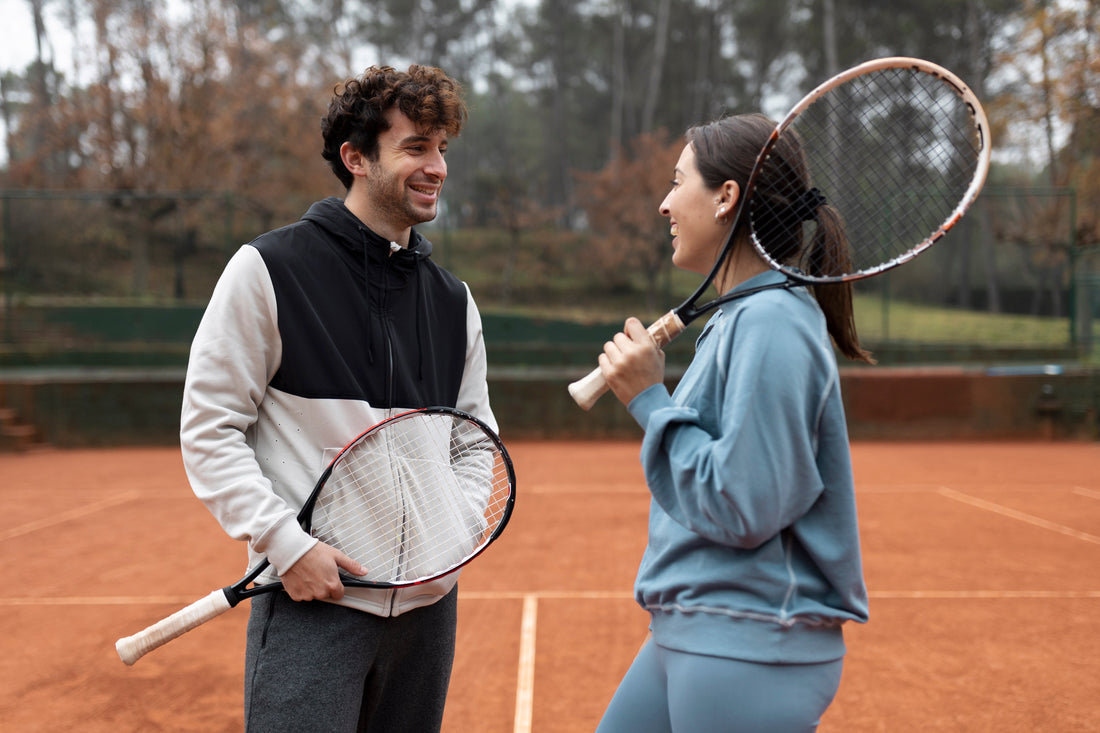
How to choose the right Tennis Racket
Share
How to Choose the Right Adult Tennis Racquet
Selecting the perfect tennis racket is very important. Whether you're a beginner or intermediate or advanced player, the right racket can make all the difference in your performance. Understanding key factors such as head size, weight, and balance when making this decision.
1. Head Size & Weight
Tennis racquets are typically divided into two main elements of racket construction : Head size and Weight
HEAD SIZE
It falls into one of these 3 categories:
- Midsize - 85-97 in2 / 550-625 cm2
- Mid-plus - 98-105 in2 / 630-680 cm2
- Oversized - 106-135 in2 / 685-870 cm2
A larger head size provides more power and a larger sweet spot, which can help beginners and intermediate players. Smaller heads give more control and precision, making them better for advanced players.
Weight
It falls into one of these 2 categories:
- LIGHTER RACKETS - 255g to 283g
- HEAVIER RACKETS - 300g to 340g
Heavier racquets offer more stability and power, but they are harder to maneuver. Lighter racquets provide easier maneuverability and spin, which is beneficial for beginners or players who focus on quick strokes. A racquet’s balance (head light, head heavy, or even balanced) influences how it feels during play. Head-heavy racquets add power, while head-light racquets offer better control and maneuverability.
- Summary
- For Beginners: Choose a light racquet with an oversized head (105-132 square inches). This will provide a larger sweet spot, helping you hit the ball more consistently. Look for racquets around 255g to 283g in weight with a larger head size (105 square inches or more).
few things to look for:
- Oversize head size
- Lighter frame
- More power
- For Intermediate Players: You can start opting for a racquet with a midplus head size (98-105 square inches) and a medium-weight frame. This offers a blend of power and control, allowing you to develop more advanced techniques.
few things to look for:
- Oversize or Midplus head size
- Medium weight frame
- Less power generated from the racket, more control
- For Advanced Players: Opt for a racket with a mid-sized head (85-100 square inches) and a heavier frame (300g to 340g). These racquets provide maximum control, precision, and feel, ideal for players with developed skills.
few things to look for:
- Midplus to Midsize head size
- Medium to heavy weight frame
2. Racket Length
- The standard length for a tennis racquet is 27 inches, but longer racquets can offer more reach and power, particularly for serves. However, they may also be harder to control.
3. Balance
- A head-light racket will have more of its mass located toward the handle end of the racket, whereas a head-heavy racket has more weight at the tip of the racket.
- A head heavy racquet : more power, more stable through swing but more difficult to maneuver, is generally used by baseliners.
- A head lighter racquet:. Reduced vibration in the handle but easier to maneuver, can be the better choice for a classic volley player
4. String Pattern
There are 2 types:
- Open pattern (16x18 or 16x19 ) most common ( More Power )
- Dense pattern (18x20) most common ( More Control )
5. Material
There are 3 types of tennis racket frame materials:
- Carbon Fiber : most powerful, stable and durable performance but less arm-friendly feel, most expensive.
- Graphite: efficient shock absorption, nice blend of power and control but less durable, not as strong as carbon fiber ( most common and best for Intermediate and advanced players).
- Aluminum: soft, lightweight feel at low price unit but less powerful, more feedback upon contact with ball ( best for beginners who wants lighter racket with easy comfortable swings).
5. Grip Size
- Racket grip sizes are measured 0 through 5. It’s very important to play with the proper grip size as it makes a big difference in how your hits will perform.
- Grip size 2 and 3, These are the most common grip sizes based on gender. However, if your hand is much smaller or larger, you may need a different grip size.
- If in-between two sizes choose the smaller one and eventually build up your grip size with an overgrip
-
The correct grip size is the one that, when holding an eastern forehand grip, allows you to exactly fit the index finger of your non-hitting hand in the space between your fingers and your palm like the image below.

